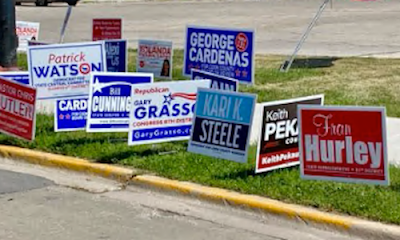Managing Editor
Throughout the course of my life, there have been individuals who have been behind the scenes but nevertheless turned out to be key to my personal and professional development and whom I am today.
These are people that I wouldn’t say I was particularly close to, yet I learned something from them that I’ve been able to apply to the way I approach life and especially my work as a journalist.
Here are three individuals who played some role in making me the person I turned out to be.
While in eighth grade at Carlton Webster Junior High School in Henrietta, New York in the fall of 1966, I signed up to use my extra period as a school library aide. The school librarian was Mary Helen Sneck, a tiny grey-haired woman in her 60s who said she knew the Dewey Decimal System better than she knew the alphabet.
Miss Sneck could tell you the precise location of a book in the school library, who the book’s author was, and the Dewey Decimal code for the book just by telling her the title. I was one of about a dozen library aides that school year and she was so pleased with my volunteer work three days a week that I was invited back to serve in the same position for my ninth-grade year in school.
She was stern, but fun to work for, and if she liked something you were doing, you would get invited into her office behind the checkout desk where she kept a tin filled with Dentyne chewing gum or Mary Jane wrapped peanut butter and molasses candy.
Each year at the end of school she would close the library at lunchtime and have an indoor picnic featuring ham salad sandwiches she would make herself for the library volunteers, potato chips and some small cups of cherry ice cream.
Then one by one, she would call your name and hand you a certificate and thank you for your service to the library. The other day I found one of those certificates in a box in my basement and thought about Miss Sneck for probably the first time in half a century.
More than anything else, I learned organization from her. She taught me to keep all the Dewey Decimal cards for the books in numeric order, making it easier to place books on carts to take back for placement on the library shelves. I’m still using those organizational skills today, except now on a much larger scale trying to keep tabs on dozens of newspaper articles for each issue.
I never told Miss Sneck thanks for helping me, but I think she knew.
Serving in the Air Force, my immediate supervisor, Technical Sergeant Bill Crosland, helped me adjust to being the lowest ranking airman at our detachment site. He often steered me to make more prudent decisions about various issues, instead of jumping to conclusions and making snap judgements about people or situations.
His cautious approach to solving problems was the result of many years spent in military service and he was perhaps the most rational person I have ever known as an adult. He always thought things through before speaking and took his time doling out discipline to subordinates or dealing with officers leading our squadron.
Years later when I am faced with a difficult work problem, I find myself thinking about what Bill Crosland would have done if he were sitting in my chair.
Then there’s Coach Andy Sykela, the chair of the Physical Education Department when I attended Rush-Henrietta High School. During gym class my sophomore year, I mentioned to Coach Sykela that my goal was to obtain my athletic varsity letter from the school but didn’t feel I was good enough to play for any of the school’s sports teams.
He told me that I could earn points toward earning my letter by serving as a manager for school sports teams. Eventually I became a manager for the school’s varsity basketball team and kept the official scorebook for each game at the scorer’s table.
It was challenging work keeping track of all the fouls, baskets, and free throws, and turned out to be excellent preparation for my career as a sportswriter. (To this day, I still believe the best job I’ve ever had was covering high school basketball games for a newspaper I worked for in Florida.)
At the end of my junior year of high school, I proudly walked on stage to receive my high school varsity letter from guest speaker “Sleepy” Jim Crowley, one of the legendary “Four Horsemen of Notre Dame,” and none other than Coach Andy Sykela.
I never got to know each of these instrumental individuals I’ve mentioned very well, yet they each saw something in me that prompted them to help guide me when I was young.
Mary Helen Sneck, Bill Crosland and Andy Sykela may have been peripheral people in my life, but their influence over me continues to this day. I’m certainly grateful for what they did for me, but the highest appreciation I can offer to them now is not praise, but to live by their example. <









